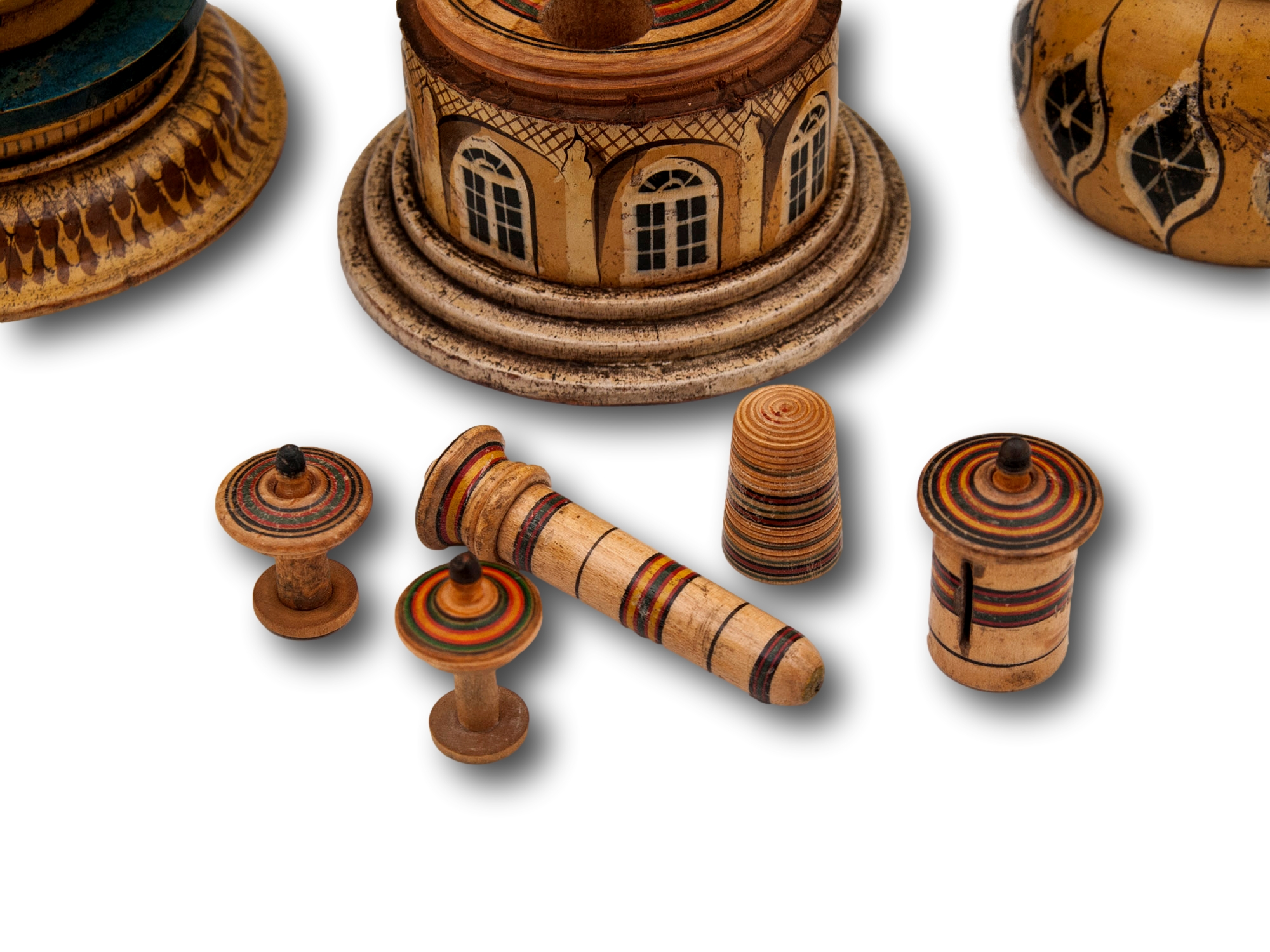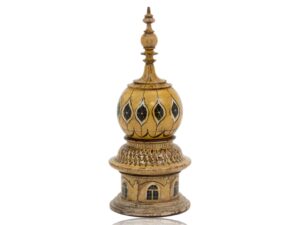Brighton Pavilion Tunbridge Ware Sewing Compendium
SOLD
Rare Tunbridge Ware Form Sewing Compendium From our Tunbridge Ware collection, we are delighted to offer this very rare Tunbridge Wear Sewing Compendium. The Sewing Compendium modelled as a tower from the Brighton Pavilion features the iconic minaret turned in... Read More
Georgian Period Sewing Compendium Circa 1825
| Dimensions | 9.5 × 9.5 × 21.5 cm |
|---|---|
| Period | |
| Year | |
| Country | |
| Medium | |
| SKU | 500263 |
Description
Description
Rare Tunbridge Ware Form Sewing Compendium
From our Tunbridge Ware collection, we are delighted to offer this very rare Tunbridge Wear Sewing Compendium. The Sewing Compendium modelled as a tower from the Brighton Pavilion features the iconic minaret turned in Sycamore (aka white wood) and a large globular body with hand-painted details leading to further turned faces and the hand-painted windows upon a stepped base. The Sewing Compendium opens in two locations one just below the first dome revealing a pin cushion and the second just above the windows revealing the Sewing tools including a Tunbridge Ware thimble and bobbin. The Tunbridge Ware Sewing Compendium dates to the Georgian era during the reign of George IV circa 1825.
Brighton Pavilion, The Royal Pavilion and surrounding gardens are a Grade I listed property and were the former Royal residence located in Brighton, England. It was built in 1787 in three stages as a seaside retreat for George, Prince of Wales who became the Prince Regent in 1811 and then King George IV in 1820. It is built in the Indo-Saracenic style prevalent in India for most of the 19th century. The current appearance of the Pavilion which has various domes and minarets, is the work of architect John Nash, who extended the building starting in 1815. George IV’s successors William IV and Victoria also used the Pavilion but Queen Victoria decided that Osborne House should replace the Pavilion as the royal seaside retreat and therefore the Pavilion was sold to the city of Brighton in 1850.
Indo-Sarascenic refers to a cross between Indian architecture and Muslim architecture.
Minarets means beacon in Arabic. In Islamic religious architecture, the tower from which the faithful are called to prayer five times each day by a muezzin, or crier. Such a tower is connected to a mosque and has one or more balconies or open galleries. The inspiration for the minarets features on the Brighton Pavilion are in homage to these types of finials.
John Nash (1752-1835) was one of the most prevalent British architects from the Georgian and Regency periods. He was responsible for the design, in the neoclassical and picturesque styles of many important areas of London. He was financed by the Prince Regent and by the era’s most successful property developer, James Burton. Nash’s most famous designs were the Brighton Pavilion, Marble Arch and Buckingham Palace.
Sycamore is a member of the Maple family, found in Europe. It is light yellow in colour and is often a very clean wood, with a straight, fine grain. The wood is often pippy. However, these pips are usually a very similar colour to the rest of the wood making them hardly visible.
Georgian, a period in British history dating from 1714-1837, the Georgian era after the Hanoverian kings George I, George II, George III and George IV.
Tunbridge Ware
Tunbridge Wells and Tunbridge in Kent, England became popular in the 17th Century for their therapeutic waters. By the 18th century, Tunbridge Wells was a hugely popular Spa resort. Shops and stalls were set up to sell local work of distinction to visitors as souvenirs. Many of the original boxes were decorated with all sorts of different kinds of designs. Many of the Tunbridge boxes had a central image with views of castles, churches, pavilions, animals, country scenes and sometimes people, such as the Young Prince of Wales. These were surrounded by a variety of bandings and panels of floral and geometric designs. Tunbridge Ware items originate from the beautiful spa town of Royal Tunbridge Wells in Kent. We always have a very good selection which showcases the techniques of tessellated mosaic, stick ware, perspective cube mosaic, vandyke and painted pen work. We always have a selection of artworks and pieces which showcase the techniques of tessellated mosaics, stick ware, perspective cube mosaics, vandykes and painted pens.
With every purchase from Mark Goodger Antiques, you will receive our latest catalogue, a Certificate of Authenticity, detailed care instructions for your chosen piece and an independent invoice (for insurance purposes) will be enclosed. As well as being protected by a no-hassle, money-back policy, your piece will be entirely insured during the shipping process to ensure the safety of your item.
Additional information
Additional information
| Dimensions | 9.5 × 9.5 × 21.5 cm |
|---|---|
| Period | |
| Year | |
| Country | |
| Medium | |
| SKU | 500263 |












